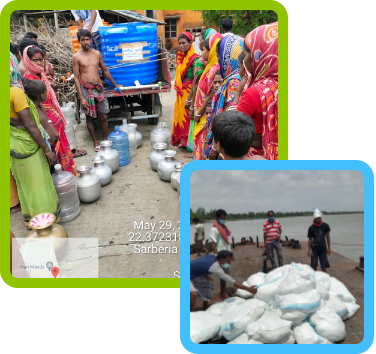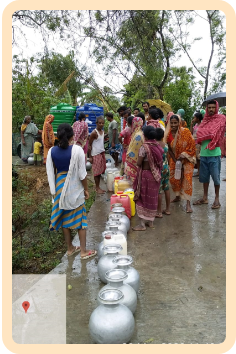

A disaster is defined as a disruption on a massive scale, either natural or man-made, occurring in short or long periods of time. It often puts a vast majority of the affected population at health risk, claims human and animal lives, devastates household and public infrastructure. Almost all the states of India are vulnerable to some form of natural calamities like floods, droughts, cyclone, tsunami, earthquake, etc.
In West Bengal, every year natural disasters like droughts, cyclones and floods are common. Further, climate change has led to the exacerbating of disasters, both in numbers and complexity, in the lower Gangetic basin of Bengal. In recent years, we have witnessed two of the deadliest cyclones in West Bengal’s history, Cyclone Amphan (2020) and Cyclone Yaas (2021) which wreaked havoc in the Sundarbans (South 24 Parganas district) and its adjacent districts. The geographical location of West Bengal also makes it vulnerable to year-round flooding from the Teesta, Damodar, Kansabati and Subarnarekha river systems.
Water supply and sanitation in particular, often becomes the most crucial needs of the disaster-affected population, especially women and children. The onslaught of natural disasters may lead to outbreak of epidemics like cholera, diarrheal diseases, dengue, malaria, typhoid etc. It is possible to mitigate, if not prevent, the adverse impact of disasters, by planned disaster risk reduction interventions on water supply, sanitation and hygiene by State Government and other stakeholders.
The Public Health Engineering Department is tasked with the responsibility to minimize causalities and enable quick recovery, restoration and rehabilitation of access to safe drinking water and emergency sanitation for the disaster-affected population.
In order to provide the above-mentioned services to the people, the PHED collaborates with the Disaster Management Department along with the Chief Minister’s designated disaster management task force. This ensures coordination and cooperation among the various stakeholders remains relevant and effective for both preparedness and relief work before and after a disaster.
Institutional Mechanisms undertaken by PHED in disaster-affected areas

Public Health Engineering Department, Govt. of West Bengal © 2018
Site best viewed with 1024x768 resolution in Google Chrome 31.0.1650.63, Firefox 55.0.2, Safari 5.1.7 & IE 11.0 and above